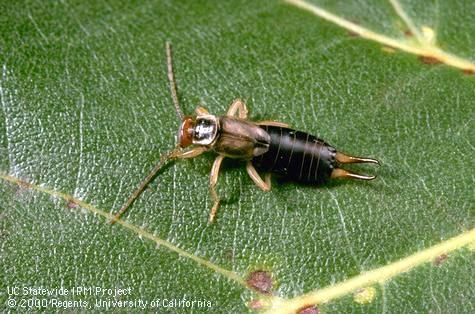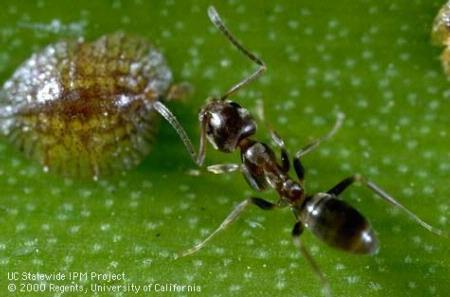
Posts Tagged: aphids
Earwigs are Good?
It seems the humble earwig that can cause so much damage in citrus orchards in some years on some small trees can be a great boon in biocontrol. Read on:
WSU scientists unmask the humble earwig as an apple-protecting predator
By Seth Truscott,
College of Agricultural, Human, and Natural Resource Sciences
https://news.wsu.edu/2019/06/05/wsu-scientists-unmask-humble-earwig-apple-protecting-predator/
Helping Northwest apple growers protect their crops, WSU scientists have found new proof that earwigs are actually valuable predators in apple orchards, rather than the creepy, crawly, apple-damaging pests they're sometimes assumed to be.
In the May 2019 edition of the journal Biological Control, Robert Orpet, recent doctoral graduate at Washington State University's Tree Fruit Research and Extension Center, details findings from his multi-year effort to shed light on the European earwig and its role in combating a costly orchard pest.
“Earwigs will eat just about anything, but we've found that aphid pests are high on their menu,” Orpet said. “By dining on pests and reducing growers' need to spray insecticides, earwigs are unappreciated predators that have important benefits for agriculture.”
Shy, invasive omnivore
An invader in U.S. orchards and gardens, the European earwig was first found in Seattle in 1907, spreading across the continent soon after. With their wriggly bodies and scary-looking tail pincers, earwigs have always suffered from a bad reputation.
“Apple pickers don't like them, because they have a tendency to hide in apple clusters,” Orpet said. “Farmers often find them inside damaged fruit, and since earwigs feed mostly at night, it's hard to see what they feed on. “Some growers wonder if they cause damage themselves.”
Scientists like Orpet, however, have long suspected that earwigs are an important predator of aphid pests.
Apple trees covered in “snow”

Orpet came to the earwig through his research into the woolly apple aphid, a costly pest of Washington's $2.4 billion apple industry.
Gaining its name from their coat of cottony fibers, woolly apple aphids feed on the roots and branches of apple trees, stealing nutrients and water and causing galls, or abnormal growths. Infestations can decrease tree growth and keep fruit from developing, while the aphid's sticky honeydew secretions can bring on fungal infections.
About the size of a sesame seed, woolly apple aphids can amass in fluffy, meter-long colonies.
“In bad years, infestations make apple trees look like they're covered in snow,” Orpet said. “That's when growers really take notice.”
Growers have difficulty managing woolly aphids with insecticides, because there are few effective insecticides, and no organic ones, currently available. Well-known predators like ladybugs and lacewings could take a bite out of the woolly aphid population, but Orpet wanted to know if the earwig makes a difference.
Working with Jessica Goldberger, an agricultural sociologist at WSU's Department of Crop and Soil Sciences, Orpet interviewed 15 orchardists and managers in Washington state, gauging their opinions on the insect's role.
Most growers weren't sure whether earwigs make a real difference for their crops, and some thought of them as minor pests.
At the same time, Orpet was learning what earwigs are really up to in Washington orchards. Working with managers at four different commercial orchards, Orpet set about catching earwigs with cardboard traps.
Aphids: Earwigs' favorite food

Active at night, earwigs hide by day in tight spaces. Corrugated cardboard sheets are a perfect shelter, so he could easily shake them out and count them.
Sectioning off orchards, Orpet removed earwigs in some places, adding them at others. In every site, he counted woolly aphid colonies and checked for fruit damage.
“There was an obvious difference,” Orpet said. “There were fewer aphid colonies in places where I released earwigs.” He found no evidence that earwigs were causing damage themselves, but captured video footage of earwigs eating aphids and destroying their colonies.
Orpet also inspected the contents of trapped earwigs' digestive systems to see what they actually eat. He found that earwigs regularly dine on aphids, even when local aphid populations are small.
“Our results show that earwigs aren't pests, and actually improve biological control,” Orpet said. “Some farmers spray chemicals to knock down their populations, but this research shows they don't have to, and probably shouldn't.
“Growers can reduce pesticide use, save on chemicals and labor, and leave this misunderstood predator to do its beneficial work, protecting their apples from aphids,” he added.
Along with Orpet and Goldberger, co-authors include WSU entomology professors David Crowder and Vince Jones.
Their research was funded by the Washington Tree Fruit Research Commission, USDA's National Institute of Food and Agriculture, and the Western Sustainable Agriculture Research and Education Program.
Media contact:
- Robert Orpet, doctoral graduate, Department of Entomology, 847-337-4480, robert.orpet@wsu.edu

earwigs
Avocado Aphids?
If you hang around an orchard long enough something unusual will show up, especially when seasons change and there's more rain than usual and it's cold, but not so cold that it freezes and it's prolonged. So out of San Diego comes a request for an identification of a brown bump on avocado stems. It's a brown aphid. Is it something of concern? Likely not. Over the years there have been reports of several aphids on avocado. Check out Walter Ebeling's "Subtropical Fruit Pests" at Avocadosource.com:
http://www.avocadosource.com/papers/research_articles/ebelingwalter1959b.pdf
These things come and go, and they don't do any damage because once the biocontrol bugs get going, they are fresh meat for them.

avocado aphids

avocado aphids close
Control Argentine Ant and Biocontrol Can Really Work
Argentine Ant is a very aggressive invader that disrupts native ant populations and at the same time disrupts biocontrol agents that help control, such pests as scale, aphids and mealy bugs in citrus and other tree crop species. They defend these sugar producing sources of energy from attack by predators and parasites, like parasitic wasps and predatory assassin bugs and lady bugs. They increase the threat of Asian Citrus Psyllid and HLB by protecting the psyllid from attack by parasitic Tamarixia.
A careful, well placed chlorpyrifos spray has been used to control Argentine ants. A trunk spray and/or spray on irrigation lines has disrupted their activity with minimal impact on beneficials. This protectant spray keeps the Argentine ants out of the canopies and allows the beneficials access to the pests. Controlling this one species, can have significant impact on biocontrol and the whole need for controlling pests.
Chlorpyrifos is a pesticide that might lose registration and other materials and techniques have been examined over the years as a replacement. A recent procedure has been proposed and used successfully on Santa Cruz Island to control introduced Argentine ants. The ant has caused tremendous disruption in biocontrol and it appears to have been controlled by this new technique. We are in the process of evaluating it's use in citrus. The application technique, costs and materials would need to be modified for use in citrus orchards. The current procedure would not be considered an organic practice since the pesticide material is not registered organic. It might be possible to use an organically registered material in the future.
Protocols for Argentine ant eradication in conservation areas
L.Boser1,C.Hanna2,D.A.Holway3,K.R.Faulkner4,I.Naughton3,K.Merrill5,J.M.Randall1,C.Cory1,D.-H. Choe6 & S. A.Morrison
Journal of Applied Entomology
http://onlinelibrary.wiley.com/doi/10.1111/jen.12372/full
The Argentine ant (Linepithema humile) is a widespread, abundant and ecologically disruptive invader that is present throughout major portions of coastal California and on half of the California Channel Islands. On Santa Cruz Island, the Argentine ant had invaded about 2% of the island's area in four distinct locations as of 2012. Given the negative ecological effects resulting from Argentine ant invasions,we sought to develop a cost-effective method of eradication. Here, we describe the results of large-scale, field-tested methods for Argentine ant eradication and post-treatment detection. Our eradication protocol employs a novel toxicant-delivery system: an aqueous solution of sucrose and 6 ppm of thiamethoxam mixed with hydrating polyacrylamide beads. Ants feed on the solution present on the bead's surface for about 24h after which time bead dehydration prevents feeding. We distributed hydrated beads by helicopter over 74 ha of infested areas plus a 50-m buffer on 14 occasions between June 2013 and September 2014. Treatments reduced Argentine ant activity to subdetectable levels within four months. In 2014, we conducted a high-intensity detection protocol using lures (n = 55 363) in areas treated in 2013.This effort did not detect Argentine ants. In 2015, we conducted a medium-intensity detection protocol using lures (n=2250) in areas treated in 2013 and 2014 but not searched in 2014; this sampling effort did not detect Argentine ant activity except for a single remnant infestation (c.0.3ha in area),which was retreated in2015.Thec ost of treatments was approximately $1400 per ha; this cost is comparable to other ant eradication efforts. The cost of our preferred detection method, which used lures spaced every 10m,was $500 per ha.These results demonstrate sufficient protocol efficacy to justify expansion of treatments to other infested areas in ecologically sensitive areas.
Photo: Argentine ant and scale

argentine ant and scale
